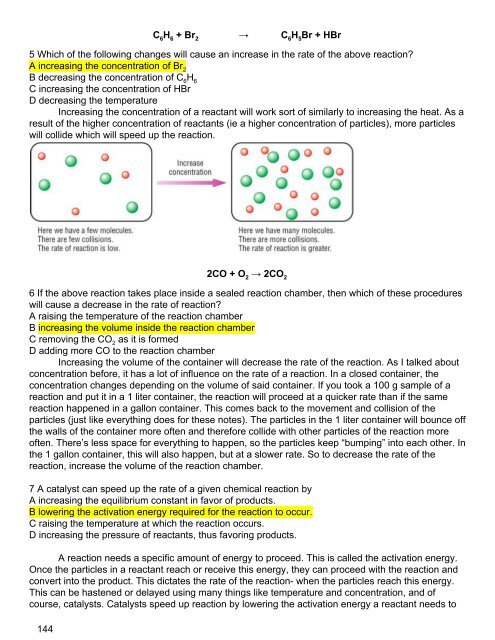You also want an ePaper? Increase the reach of your titles
YUMPU automatically turns print PDFs into web optimized ePapers that Google loves.
C 6<br />
H 6<br />
+ Br 2 <br />
→ C 6<br />
H 5<br />
Br + HBr<br />
5 Which of the following changes will cause an increase in the rate of the above reaction?<br />
A increasing the concentration of Br 2<br />
B decreasing the concentration of C 6<br />
H 6<br />
C increasing the concentration of HBr<br />
D decreasing the temperature<br />
Increasing the concentration of a reactant will work sort of similarly to increasing the heat. As a<br />
result of the higher concentration of reactants (ie a higher concentration of particles), more particles<br />
will collide which will speed up the reaction.<br />
2CO + O 2<br />
→ 2CO 2<br />
6 If the above reaction takes place inside a sealed reaction chamber, then which of these procedures<br />
will cause a decrease in the rate of reaction?<br />
A raising the temperature of the reaction chamber<br />
B increasing the volume inside the reaction chamber<br />
C removing the CO 2<br />
as it is formed<br />
D adding more CO to the reaction chamber<br />
Increasing the volume of the container will decrease the rate of the reaction. As I talked about<br />
concentration before, it has a lot of influence on the rate of a reaction. In a closed container, the<br />
concentration changes depending on the volume of said container. If you took a 100 g sample of a<br />
reaction and put it in a 1 liter container, the reaction will proceed at a quicker rate than if the same<br />
reaction happened in a gallon container. This comes back to the movement and collision of the<br />
particles (just like everything does for these notes). The particles in the 1 liter container will bounce off<br />
the walls of the container more often and therefore collide with other particles of the reaction more<br />
often. There’s less space for everything to happen, so the particles keep “bumping” into each other. In<br />
the 1 gallon container, this will also happen, but at a slower rate. So to decrease the rate of the<br />
reaction, increase the volume of the reaction chamber.<br />
7 A catalyst can speed up the rate of a given chemical reaction by<br />
A increasing the equilibrium constant in favor of products.<br />
B lowering the activation energy required for the reaction to occur.<br />
C raising the temperature at which the reaction occurs.<br />
D increasing the pressure of reactants, thus favoring products.<br />
A reaction needs a specific amount of energy to proceed. This is called the activation energy.<br />
Once the particles in a reactant reach or receive this energy, they can proceed with the reaction and<br />
convert into the product. This dictates the rate of the reaction- when the particles reach this energy.<br />
This can be hastened or delayed using many things like temperature and concentration, and of<br />
course, catalysts. Catalysts speed up reaction by lowering the activation energy a reactant needs to



